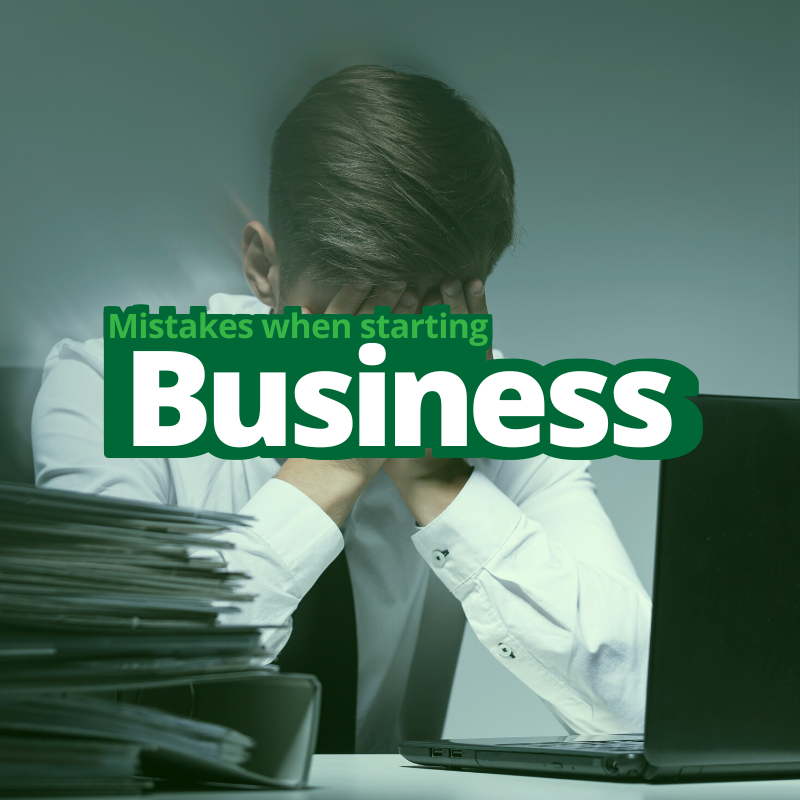Business
Common Mistakes When Starting a Business

AVOID THESE MISTAKES IN STARTING A BUSINESS
As a new business owner, it’s crucial to remember that not every business effort succeeds. If you don’t take the time to undertake the correct kind of preparation and investigation, your firm is guaranteed to fail. While being excited and motivated is crucial, ensuring you do everything you can to guarantee you’re genuinely ready for that opening day will be essential. Furthermore, if you make these errors once, you are more likely to repeat them in the future. Don’t be one of these people who will push you further from your goals. Find out how to get off to a good beginning with your new venture by avoiding the typical pitfalls entrepreneurs face. And this is where everyone, no matter how driven they are, fails…
Mins to Read: 8-10 Minutes
Age Bracket: 16-50

The pitiful return earned on savings wouldn’t be enough to prevent you from losing what you already had to the passage of time. Keeping your money in your account earns you little interest, not enough to prevent your money from losing purchasing power to inflation over time. While it’s admirable that you’re able to set money aside regularly, the savings you’ve accumulated should be put to better use rather than sitting idle in a savings account. Instead, you should invest it in a portfolio of products designed to provide the highest possible return with the least likely exposure to loss.
Refusing to Create a Formal Business Plan
It’s challenging to start a successful company and set yourself apart from the competition without first writing a business plan. You have a great shot at realizing your dreams when you have a well-thought-out business strategy and the momentum that comes with it. It’s hard enough to manage a small company as it is, so you should give yourself every edge you can.
Despite this, many startups launch their operations without first considering the larger picture. When things go wrong, they waste time, money, and effort because they don’t know enough about the market, finances, company strategy, or logistics. In addition, they do not have a guiding principle to rally behind during difficult times.
Do not make this rookie error by failing to create a business strategy that will assist you in recognizing the gaps and identifying the unknowns. Should you use a 3PL or handle the shipping yourself? When will you start making stuff? To whom are you trying to sell?
Your business strategy should inform every aspect of your product development. This will assist you in avoiding deviating from your course and ensure that your firm succeeds in meeting its objectives. Have no idea where to begin? Please make use of the free business plan template we have provided.
They Ignore the Most Critical Need for a Successful Business.
Most ambitious business owners avoid putting their own needs before their clients. It would help determine where your intended business and consumers’ demands and wishes converge. Never develop a company concept just because you think it’s cool. Most wannabe business owners fail because they have narrow-minded ideas about how their company should operate.
You cannot run a company without clients interested in what you have to give. To prevent making this error, try these:
- Conduct market analysis
Likely, you don’t have a winning concept if you can’t find anything online that is comparable to your idea. You may test product ideas on various websites, including Google Search, Amazon, Quora, and Facebook Groups.
- Speak with your present and prospective clients.
Get input from your audience or customer base if you have one. Use groups and forums to get ideas if you don’t have a following or clients. Instead of attempting to sell straight away, concentrate on providing value and asking open-ended inquiries.
- Make a minimal viable product and continue to iterate over time.
You wish to develop an initial product to sell after researching your concepts, such as version 1.0 of an online course or a sample of an e-commerce product. You may verify the idea before you produce the product by getting customers to pay for it.
Overlooking cash flow and Sales
Entrepreneurs often neglect to pay attention to cash flow and profit margins. Any seasoned business owner will tell you that arithmetic is the most crucial ability for managing a company. Many company owners start their venture as a pastime and don’t give the metrics the attention they need.
Business math is exceptionally straightforward. Use this method to see how successful your firm may be:
Profit = Demand x (Revenue – Expenses)
Let’s examine the profit as mentioned above calculation. Assume 20,000 individuals per month are looking for your goods online. There are 10,000 potential customers if you can get in front of even half of them.
100 to 200 sales would result from a conversion rate of between 1% and 2%. Your profit will range from Php 150,000 to Php 300,000 per month if your average order value is Php 5,000 and your net profit margin is 30%.
These are, of course, very approximate estimations. But if you’ve done the math, you know what you’re getting into no matter what. Use the technique above to monitor your prospective earnings and cash flow to avoid making this typical error.
They Are Unconscious of the Illogical Element of Time.
“Most people overestimate what they can do in one year and underestimate what they can do in ten years.”- Bill Gates
Instead of comprehending that the first 20% of the trip contributes to 80% of the outcomes, they believe that every step will be just as challenging as the first few and that the process will be challenging the whole time.
It would help if you got through the novice level; when each step is challenging, you still acquire the necessary abilities and micro-skills to gain momentum, and you don’t fully comprehend the sector. Once you have traction—a small audience of leads flowing in and some sales—you’ll gradually understand the intricacies necessary to succeed.
Most would-be business owners give up before they complete the first 20 percent of their trip. Then, without ever creating a successful company, they repeat the cycle of launching new projects, giving up, and starting again. Overcoming the 20% threshold Without taking a day off, aim to grow your company for 90 days straight. Reach six months. You’ll be well on creating a genuine company by the end of an entire year.
Neglecting To Test Your Business Idea
Not doing market research is one of the worst errors you can make when starting a new company. You want to get familiar with the opposition and comprehend how you might set yourself apart from them. Competition might come from smaller companies that sell the same goods as you or from industry leaders like Amazon and Walmart.
Sometimes business owners enter a specialized industry without deciding whether they are a suitable match. There are times when a niche has too many firmly established competitors and little to no demand. If so, you may not want to create a company around it.
You’ll need to do some study to comprehend the market environment. Locate the rivals in your niche and have a look at the following:
- number of reviews seen online
- Social interaction
- Blogging routines
- media coverage
- ranks for search engine optimization (SEO)
You should also determine if the market is sustainable and one in which you can build a presence over time rather than merely a fad.
They Engaged in “Tactical Hell” in Marketing.
E-commerce, affiliate marketing, and freelancing/service provision are just a few of the many viable options out there. Numerous online mediums and methods, including email marketing, sponsored advertisements, and search engine optimization (SEO), are available for your company’s promotional needs. In addition, there are various social networking sites from which to choose.
Most would-be business owners try their hand at everything, which usually ends with them being average at best. What Ramit Sethi refers to as “marketing tactical hell.” If you’ve been told, “You need to do all these things to get your company going,” you know what marketing tactical hell sounds like. You can’t afford to ignore platforms like Pinterest, Facebook, Twitter, email, and webinars. The only thing you can say is, “What? When asked, “Where do I begin? Do all of them. Please do not take their advice.
The worst marketing strategy is trying to cover all your bases while making no progress. Methodical, planned, and calculated. Whenever you reach this point, you should remark, “You know what? Most of those tasks are not on my to-do list. I will focus on 2 of the critical aspects of my life and master them thoroughly.
Get good at stacking things up instead:
- Pick a model
Select one business concept for which to develop a minimal viable product, test its viability in the marketplace, and refine it based on the results. Instead of giving up on online sales and switching to affiliate marketing, focus on improving your current online store.
- Select one medium for advertising.
The goal is to zero down on one channel, whether gratis or paid, that can bring in a steady stream of customers. In contrast to sponsored strategies like Facebook Ads, organic ones like search engine optimization (SEO) are free to use.
- Learn how to use one social networking site initially.
Focusing on mastering a single social media site might provide better results than spreading yourself too thin.
Not carefully Considering Freebies and Prizes
Overspending on marketing tactics such as giveaways and competitions is a leading cause of business failure. Many people succeed by handing out freebies.
Though promotions like freebies, sweepstakes, and giveaways are very successful, they aren’t always the best match for a product’s target demographic. Products that quickly expire or are used up, such as skin care items, food, and dietary supplements, might benefit from free samples. It’s not easy to make it work for anything else, even if it’s something that might be ordered again, like an article on clothes.
Not Having a Reliable Marketing Plan
If you don’t prepare for anything, you’re setting yourself up for failure. Setting up a marketing strategy for an e-commerce website should be straightforward if you have already done your research on your target audience.
Without this knowledge, your marketing efforts are like tossing spaghetti at a wall, hoping that some of it would stick. The fact is that 313% more success will be reported by marketers with a defined approach. Every e-commerce company needs a comprehensive marketing strategy, but specific methods will work better than others. Pay-per-click (PPC) advertising is effective for certain companies, while search engine optimization (SEO) and social media marketing are more effective for others. A reliable sales medium is email.
Make sure that anything you’re planning is in place before you start. Opportunities will emerge, and if your foundation is solid, you can capitalize on them without sacrificing stability or scalability.
They Never Leave their Comfort Zone.
Without taking action, you will get no closer to your company development objectives the more you engage in the “advice treadmill” search for solutions.
Nothing can replace doing anything, not even more knowledge. You may study business theory to your heart’s content by reading books, buying programs, watching videos, and listening to podcasts. Still, unless you put your idea into practice, you’ll never know whether your concept will succeed or not.
This requires you to confront your deepest anxieties, such as the worry that no one will like your new product or service when it launches. Most individuals never get around to beginning a company because of this worry. To avoid stress caused by indecision, avoid attempting to “get your ducks in a row” repeatedly.
There is no silver bullet when it comes to getting started or overcoming your concerns. Do it; it’s necessary. Avoid being stuck in a cycle of never-ending consumption with no corresponding output. It’s a fatal flaw for budding business owners. A prosperous enterprise is within your reach. But you’ll never make one if you waste your whole life in doubt.
Refusing to Hire or Add Staff
The predominant school of thinking for many entrepreneurs is going alone. “Opportunity Cost” is a term commonly used in economics. The “cost” of pursuing one opportunity is that you no longer have time to seek other alternatives. One chance thus costs you every additional option you have.
You will likely accomplish everything yourself if you are bootstrapping your own company. You created the website, played around with it, uploaded the items, wrote the product descriptions, and handled all the marketing—a magnificent one-person performance. The issue is that although doing everything oneself is excellent, it takes a lot of time. You might be doing other things with this time, like spending it with your family, coming up with fresh ideas, or business ties, to mention a few.
Although this method may cost some money, the stress and suffering you’ll save will usually exceed it. Additionally, you can often find individuals who would happily do these duties (uploading inventory, data entry, etc.) for you for a fair price.
It’s vital to eliminate pointless drudgery. I use “needless” to describe actions like spending too much time playing with your website’s logo, adjusting picture sizes, going into unnecessary detail about a button’s color, or any other slight adjustment you probably only noticed. Some of the factors mentioned earlier may increase your conversion rates. However, you won’t know until you have many customers and sales to compare it against. It would be best to avoid such items while starting your company. Particularly given that, after two hours of fiddling, you’ll feel like you accomplished a lot, but you might have used your time more effectively.
So, If you’re trying to figure out how to launch a company, one crucial step is to plan out how you’ll expand your operations over time. You want your company to succeed, but you also know that it takes time.
For this reason, give these blunders some severe consideration. If you lay the groundwork for long-term success, you’ll lessen the likelihood of going out of business within the first year. If you’re wondering what steps to take to give your company the most excellent chance of success, remember that skilled specialists are prepared to provide a hand
FAQs.
My businesses are always failed; what did I do wrong?
Entrepreneurs often neglect to pay attention to cash flow and profit margins. Any seasoned business owner will tell you that arithmetic is the most crucial ability for managing a company. Many company owners start their venture as a pastime and don’t give the metrics the attention they need. Most ambitious business owners avoid putting their own needs before their clients. It would help determine where your intended business and consumers’ demands and wishes converge. Never develop a company concept just because you think it’s cool. Most wannabe business owners fail because they have narrow-minded ideas about how their company should operate.
What should I do to make my Small Business grow?
Without taking action, you will get no closer to your company development objectives the more you engage in the “advice treadmill” search for solutions. Nothing can replace doing anything, not even more knowledge. You may study business theory to your heart’s content by reading books, buying programs, watching videos, and listening to podcasts. Still, unless you put your idea into practice, you’ll never know whether your concept will succeed or not. You will likely accomplish everything yourself if you are bootstrapping your own company. You created the website, played around with it, uploaded the items, wrote the product descriptions, and handled all the marketing—a magnificent one-person performance.
MUST-READ AND SHARE!
2023 Your Practical Wedding Guide
Your Ultimate Access to Kuwait Directories in this COVID-19 Crisis
Investments and Finance Ultimate Guide
OFW FINANCE – Money News Update that you need to read (Table of Contents)
A Devotional for having a Grateful Heart
Stock Investment A Beginner’s Guide
How To Save Money Amidst Inflation
Philippines Best Banks with High-Yield Savings Return
Essentials Before Applying For a Credit Card
Credit Card Starter Guide for Beginners
If you like this article please share and love my page DIARYNIGRACIA PAGE Questions, suggestions send me at diarynigracia @ gmail (dot) com
You may also follow my Instagram account featuring microliterature #microlit. For more of my artworks, visit DIARYNIGRACIA INSTAGRAM



Peace and love to you.